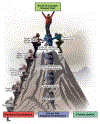Fibrosis in IBD: from pathogenesis to therapeutic targets
- PMID: 38233198
- PMCID: PMC10997492
- DOI: 10.1136/gutjnl-2023-329963
Fibrosis in IBD: from pathogenesis to therapeutic targets
Abstract
Background: Intestinal fibrosis resulting in stricture formation and obstruction in Crohn's disease (CD) and increased wall stiffness leading to symptoms in ulcerative colitis (UC) is among the largest unmet needs in inflammatory bowel disease (IBD). Fibrosis is caused by a multifactorial and complex process involving immune and non-immune cells, their soluble mediators and exposure to luminal contents, such as microbiota and environmental factors. To date, no antifibrotic therapy is available. Some progress has been made in creating consensus definitions and measurements to quantify stricture morphology for clinical practice and trials, but approaches to determine the degree of fibrosis within a stricture are still lacking.
Objective: We herein describe the current state of stricture pathogenesis, measuring tools and clinical trial endpoints development.
Design: Data presented and discussed in this review derive from the past and recent literature and the authors' own research and experience.
Results and conclusions: Significant progress has been made in better understanding the pathogenesis of fibrosis, but additional studies and preclinical developments are needed to define specific therapeutic targets.
Keywords: fibrosis; inflammatory bowel disease; myofibroblasts.
© Author(s) (or their employer(s)) 2024. No commercial re-use. See rights and permissions. Published by BMJ.
Conflict of interest statement
Competing interests: PM, WJM and YW have no conflict of interest. CF received speaker fees from UCB, Genentech, Sandoz, Janssen and he is consultant for Athos Therapeutics. FR is consultant to Agomab, Allergan, AbbVie, Boehringer-Ingelheim, Celgene, Cowen, Genentech, Gilead, Gossamer, Guidepoint, Helmsley, Index Pharma, Jansen, Koutif, Metacrine, Morphic, Pfizer, Pliant, Prometheus Biosciences, Receptos, RedX, Roche, Samsung, Takeda, Techlab, Thetis, UCB, 89Bio.
Figures






References
Publication types
MeSH terms
Grants and funding
LinkOut - more resources
Full Text Sources
Medical
Miscellaneous
